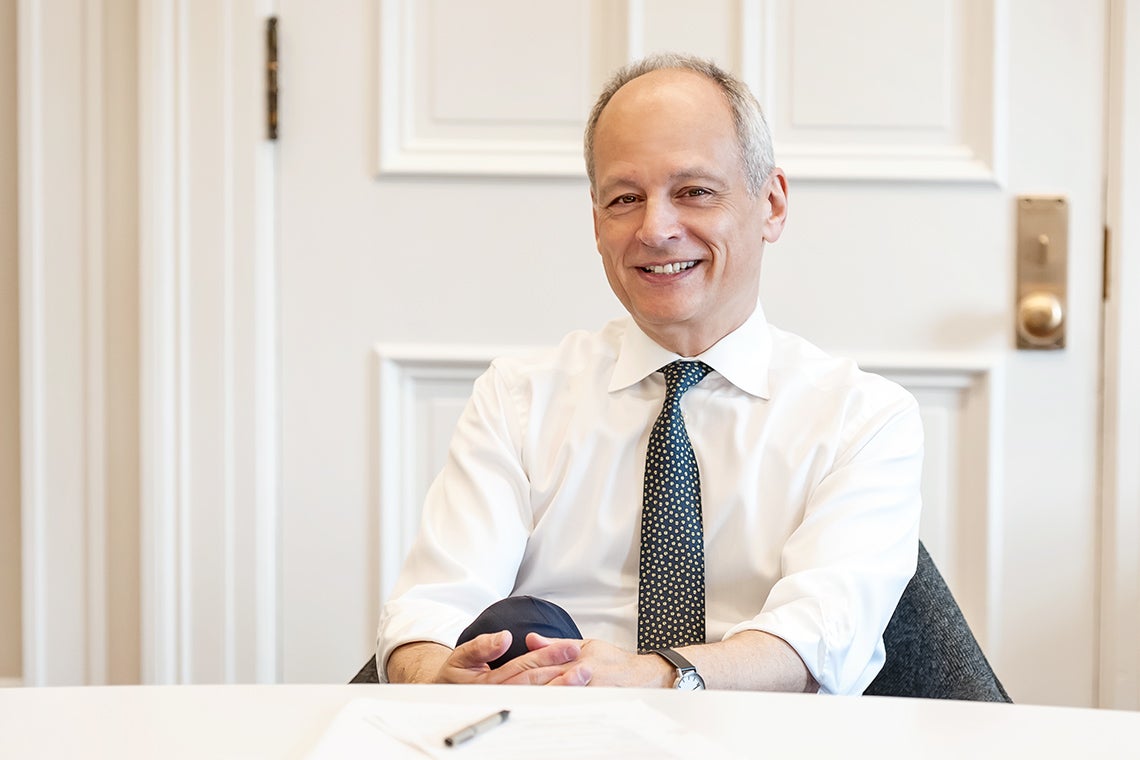
The University of Toronto is making steady progress on its commitment to reduce the carbon footprint of its investments while contributing to the broader fight against climate change through research, teaching and sustainable operations.
That was the message delivered by President Meric Gertler in a virtual discussion Tuesday focusing on the landmark “Investing to Address Climate Change” charter for Canadian universities that was initiated by U of T and McGill University earlier this year. The talk was part of the Adams Sustainability Celebration, a series of virtual events hosted by U of T’s Committee on the Environment, Climate Change, and Sustainability (CECCS) that runs until Jan. 21. It was moderated by Lisa DeMarco, a lawyer specializing in energy and climate change who is the CECCS’s alumni representative.
He discussed how the charter aligns with his 14-point plan to tackle climate change, “Beyond Divestment,” released in 2016, and he shared the progress made by U of T’s arms-length investment manager in realizing its goal of nearly halving the carbon footprint of its portfolio over the next decade.
“We have committed to trying to make as much of an impact in this battle, against this big challenge, as quickly as possible and as effectively as possible,” he said, adding that’s the reason U of T decided to slash the carbon footprint of its entire investment portfolio as opposed to simply divesting from a handful of fossil fuel companies.
“It was our assessment that pursuing a framework that directed attention to the greenhouse gas-emitting behaviour of all aspects of the economy – whether in Canada or beyond – would have the most extensive impact on moving the needle in a way that helps us achieve the Paris Agreement goals.”
Now, the “Investing to Address Climate Change” charter seeks to amplify the approach of U of T and others by calling on signatory universities to: incorporate environmental, social and governance (ESG) factors into their investment practices; measure the carbon footprints of investment portfolios regularly and set meaningful targets to reduce them over time; and engage with companies to encourage them to reduce emissions.
President Gertler said the ESG framework was adopted after studying other major institutional investors such as the Ontario Teachers’ Pension Plan and the Caisse de dépôt et placement du Québec – considered among the leaders in the responsible investing arena – and reviewing international literature on this issue.
“It was really after taking all of that input into account that we came up with a commitment to this framework, which we think has the potential of really changing behaviour across the economy rather than focusing just on one particular subset of the economy, that is, the fossil fuel sector,” President Gertler said.
He noted that University of Toronto Asset Management Corp. (UTAM), which manages more than $11 billion in assets on behalf of the university, formally adopted ESG protocols in 2016 and has committed to reducing the carbon footprint of its endowment and pension investment portfolios by at least 40 per cent by 2030. He also cited figures that show that UTAM has already made progress in reducing its carbon footprint, as defined by CO2-equivalent emissions per million dollars invested.
“In 2017, that measure stood at 139.2 tonnes of CO2 emitted per million dollars invested … in 2019, as announced in UTAM’s most recent Responsible Investing Report, our carbon footprint had already declined by 21.5 per cent to 109.3 tonnes of CO2 per million dollars invested,” President Gertler said.
Moreover, he noted that the absolute volume of carbon emissions had also declined substantially over the same period.
“So, we’ve already made quite a bit of progress just in a couple of years.”
President Gertler added that the measure of carbon emissions includes both Scope 1 emissions, or emissions from sources owned and controlled by a company or organization, as well as Scope 2 emissions, which refer to emissions generated in the production of electricity, heat or steam consumed by a company.
He stressed that the ESG approach advocated by the charter has the potential to exert a far bigger and more lasting impact on carbon emissions and sustainable business practices than simply divesting from fossil fuel companies. In fact, UTAM’s analysis has shown that selling off investments in the fossil fuel sector would reduce the carbon footprint of its portfolios by about 13 per cent while U of T’s approach would have about three times the impact, President Gertler said.
As for the charter, President Gertler called it a dynamic document that will evolve in keeping with the latest evidence and advice received from its four-person advisory committee, which comprises: Mark Carney, former governor of the Bank of Canada and the Bank of England; Michael Sabia, director of U of T’s Munk School of Global Affairs & Public Policy and former president and CEO of Caisse de dépôt et placement du Québec; Pauline D’Amboise, secretary-general and vice-president of governance and sustainable development at Desjardins Group; and Barbara Zvan, president and CEO of the University Pension Plan.
“Beyond Divestment was a local plan for U of T,” President Gertler said. “The charter is a national initiative that’s designed to inspire other Canadian universities to embrace their responsibility to take a more effective stand and more effective steps to help save the planet and help the country tackle the climate crisis.”







